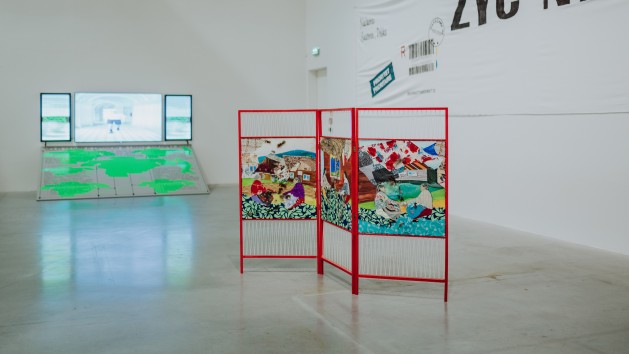The screens are artistic objects created with the use of patchwork technique, predominantly combining painting and textiles. They usually consist of three wings – panels depicting scenes from the everyday life of the Romani people. My works are not just images depicting “ordinary” scenes from the life of Roma, but also an attempt to consolidate historical, biographical, social, and political themes.
The panel screen entitled Romani Kali Daj [Romani Madonna] belongs to a series of works dedicated to Romani women who, despite their subordinate role in the traditional family model, strive for a better life through education, improvement of living conditions, and fighting for their own agency. Most women do it for their children, for whom they want a better future. Many are wise and more than capable of coping with the adversity and difficulty resulting not only from belonging to a minority group, but also from being a woman.
Like my other screens, this one uses the patchwork technique. It is a combination of painting and textiles that are often gifted to me by friends or acquaintances. One could say that these useless things get a second life. What I appreciate most are the fabrics that come from people I have a special relationship with, people who have grown important to me in some way, and who have an interesting story. These scraps carry an emotional value that, when merged into my pieces, gives them additional contexts.
I decided to repeat the same scene on each of the three wings of the screen. This is a normal, everyday activity: labor performed by the Romani women: doing laundry in a stream and plucking poultry. I have taken these motifs from archival photographs from the 1980s. Of course, each wing of the screen is different. The background for these mundane tasks are courtyards, houses, and their surroundings, typical of the settlements inhabited by the Carpathian Roma. This daily routine was accompanied by the changing aura, surroundings, and time of day or year. In this way, I wanted to convey the feeling of the passage of time.
Małgorzata Mirga-Tas
(b. 1978) – Polish-Romani visual artist, sculptor, painter, educator and activist. She belongs to the Bergitka Roma, the non-nomadic Roma ethnic sub-group that have lived a settled existence since at least the 18th century. In her work, Mirga-Tas interweaves contemporary Roma culture with historical narratives. She often focuses on the Roma women, their agency, care for the community, and their fight to change the world.
Rok powstania: 2018
acrylic, fabric, wood, screen. Courtesy of the artist and Szydłowski Gallery.

